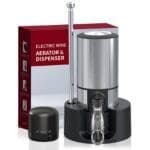As the days grow shorter and the crisp chill of winter nips at the noses of our friends in the Northern Hemisphere, there’s nothing quite like a steaming mug of mulled wine to warm our souls. With a rich history dating back to the early Egyptians, this festive wine recipe has been a favourite across cultures and ages.
So, what is the best wine for mulled wine, you ask? Let’s embark on a flavourful adventure through the world of mulled wine spices and discover the perfect warm winter drinks for those frosty evenings. Based on expert recommendations, here are the 9 best wines for making delicious mulled wine:
1. Cabernet Sauvignon: With its bold flavors and firm tannins, Cabernet Sauvignon adds depth and structure to mulled wine.
2. Merlot: Known for its fruity and smooth characteristics, Merlot is a popular choice for creating a well-balanced mulled wine.
3. Shiraz: This bold and spicy red wine enhances the warming spices in mulled wine, creating a delightful combination of flavors.
4. Zinfandel: With its rich fruitiness and slightly higher alcohol content, Zinfandel brings a sweet and robust profile to mulled wine.
5. Malbec: Offering velvety tannins and notes of dark fruit, Malbec adds complexity and elegance to mulled wine.
6. Pinot Noir: Known for its lighter body and vibrant fruit flavors, Pinot Noir creates a delicate and aromatic mulled wine.
7. Syrah: This full-bodied wine boasts intense flavors of blackberry and pepper, elevating the overall taste of mulled wine.
8. Tempranillo: With its earthy undertones and medium-bodied structure, Tempranillo adds depth and richness to mulled wine.
9. Sangiovese: This Italian wine variety offers bright acidity and cherry notes, bringing a refreshing twist to mulled wine.
Key Takeaways:
- When making mulled wine, consider the wine’s alcohol content, fruitiness, and tannins for the best results.
- The top 9 wines for mulled wine include Cabernet Sauvignon, Merlot, Shiraz, Zinfandel, Malbec, Pinot Noir, Syrah, Tempranillo, and Sangiovese.
- Each wine brings unique flavors and characteristics to mulled wine, allowing for endless possibilities and variations.
- Experiment with different wine varieties to find your favorite mulled wine recipe.
- Don’t forget to add your favorite mulled wine spices and ingredients for a truly aromatic and delicious winter drink.
Unlocking the Secrets of Perfect Mulled Wine
Creating the perfect mulled wine is part art, part science. The secret lies in striking the right balance between the mulled wine recipe, the mix of mulled wine ingredients and, of course, choosing the best wine for mulled wine. Let me take you through the key steps to achieve the warm, comforting embrace of a heavenly mulled wine.
| Ingredients | Quantity |
|---|---|
| Full-bodied red wine | 750 ml |
| Whole cloves | 8-10 |
| Cinnamon sticks | 2-3 |
| Star anise | 2 |
| Ground nutmeg | 1 pinch |
| Honey | 50 g |
| Brandy | 100 ml |
| Orange slices | 1-2 |
First and foremost, always remember the golden rule: never overheat the wine. Doing so will evaporate all the lovely alcohol and leave you with a dull, uninspiring mess. Instead, opt for wines like California Zinfandel or Touriga Nacional from Dão, which readily withstand heat.
Jared Weinstock suggests infusing spices with a “low-and-slow” approach, lightly toasting spices if preferred, before combining with the wine.
A classic mulled wine typically calls for a full-bodied red wine. Avoid splashing out on pricey bottles, as the subtle nuances of an expensive wine will be drowned out by the spices and sweetness. Plus, the sheer volume required for a batch of mulled wine renders using high-cost choices impractical. A $15 wine will do the job admirably.
- Select your wine and spices. Try different blends of spices like cinnamon, cloves, and nutmeg to dial in the desired flavour profile.
- Lightly toast the spices, being cautious not to burn them. Toasting will unlock the spices’ potential and make your mulled wine sing.
- Gently heat the wine and spice blend – remember, low and slow – so the flavours can meld harmoniously.
- Add sweeteners like honey and fortify with a splash of brandy just before serving.
- Garnish with a festive fanfare of orange slices, and you’re ready to serve!
Take these tips to heart and prepare to astonish your friends and loved ones with the perfect mulled wine recipe. Experiment with different ingredients and mix to suit your taste buds. In no time, you’ll be toasting to life’s warmest and most memorable moments.
Making mulled wine is a delightful and straightforward process that brings warmth and cheer to any gathering. While traditionally red wine is used, feel free to experiment with white or rosé wines for a unique twist. Here are some tips to help you create a delicious batch of this winter favorite:
Choose the Right Wine
When selecting wine for mulled wine, opt for a bottle that is fruity and full-bodied. Red wines such as Cabernet Sauvignon, Merlot, or Syrah work well due to their robust flavors and tannins. White wines like Chardonnay or Gewürztraminer can also produce a delightful mulled wine with a lighter and more refreshing profile.
The Perfect Blend of Spices
To infuse your mulled wine with aromatic flavors, choose a combination of spices that complements the wine’s characteristics. Common spices include cinnamon sticks, cloves, star anise, and orange peel. Feel free to experiment with additional ingredients like cardamom pods, nutmeg, or ginger for a personal touch.
Mulled wine allows for endless creativity in terms of spice combinations. Don’t be afraid to let your taste buds guide you and create your signature mulled wine flavor.
Now that you know the best wines for making mulled wine and have mastered the art of mulling, it’s time to get creative with your festive wine recipes. With a few simple twists and additions, you can elevate your mulled wine game and impress your guests. Here are some delightful variations to try:
Pomegranate Mulled Wine
Add a burst of freshness and vibrant color to your mulled wine by incorporating pomegranate juice along with the traditional spices. The tartness of the pomegranate perfectly complements the warm flavors, creating a truly festive and tangy delight.
Spiced Apple Cider Mulled Wine
Combine the comforting flavors of spiced apple cider with your mulled wine for a delightful twist. The sweet and aromatic apple cider adds depth and complexity to the drink, making it even more suitable for cozy winter evenings.
Chocolate Orange Mulled Wine
For a decadent and indulgent treat, why not infuse your mulled wine with the rich flavors of chocolate and orange? Simply stir in some cocoa powder and a splash of orange liqueur to your simmering wine. The result is a luxurious and velvety beverage that will warm both your heart and soul.
In addition to these variations, don’t forget to garnish your mulled wine with a cinnamon stick or a slice of citrus for an extra touch of elegance. You can also experiment with adding different fruits, such as cranberries or blackberries, for a delightful burst of flavor. And for an extra cozy experience, serve your mulled wine in heat-resistant glass mugs or stemless wine glasses to showcase its warm, inviting colors.
So this winter, surprise your loved ones with these festive wine recipes that will transform your mulled wine into an extraordinary sensory experience. Get creative, have fun, and enjoy the warm winter drinks that bring joy and cheer to the season!
FAQ
What is mulled wine?
Mulled wine is a cozy and fragrant winter drink that has a rich history dating back to ancient times. It is enjoyed by many cultures around the world and can be made with various types of wine.
What are the best wines for making mulled wine?
When choosing the best wine for mulled wine, it is important to consider factors such as the wine’s alcohol content, fruitiness, and tannins. Expert recommendations include red wines like Cabernet Sauvignon, Merlot, and Malbec, as well as white wines like Riesling and Chardonnay.
Can I use white or rosé wine for mulled wine?
Absolutely! While red wine is traditionally used for mulled wine, white and rosé wines can also be used for a unique twist on the classic recipe.
How do I make mulled wine?
Making mulled wine is a simple and enjoyable process. Start by heating the wine with spices, such as cinnamon, cloves, and star anise, along with sweeteners like sugar or honey. Let it simmer for a while to allow the flavors to infuse, and then strain and serve warm.
What are some tips for making delicious mulled wine?
To make delicious mulled wine, it’s important to use high-quality wine and fresh spices. You can also experiment with adding citrus fruits, such as oranges or lemons, for an extra burst of flavor. Don’t forget to taste and adjust the sweetness and spiciness to your liking.
Can I add other ingredients to my mulled wine?
Absolutely! Mulled wine offers endless possibilities for variations. You can add ingredients like apple cider, cranberry juice, or even a splash of brandy or rum for an extra kick. Get creative and make it your own!
How should I serve mulled wine?
Mulled wine can be served in different ways to suit various occasions. You can serve it in mugs or glasses garnished with cinnamon sticks or orange slices. For a festive touch, consider adding a sprinkle of nutmeg on top or serving it with gingerbread cookies.
What are some other festive wine recipes?
If you’re looking for more festive wine recipes, you can try making spiced wine sangria or a warm mulled cider with red wine. These drinks are perfect for holiday gatherings or cozy nights by the fireplace.
Are there any non-alcoholic alternatives to mulled wine?
Yes! If you prefer non-alcoholic options, you can make mulled apple cider or mulled grape juice using similar spices and flavors. These warm winter drinks are just as delicious and comforting.
Source Links
- https://www.wineenthusiast.com/culture/wine/best-mulled-wine/
- https://sundialwineandwellness.com/best-wines-for-mulled-wine/
- https://www.eater.com/22251539/best-mulled-wine-recipe-how-to-mull-wine
Sip smarter, subscribe now!
Subscribe for gourmet tips, event updates, travel ideas, and a free e-book on Food Pairings. Start your journey to culinary and travel excellence!
















Chocolate orange mulled wine sounds so delicious! 🙂 I will have to try that this winter.
Hadley
Definitely worth a try, especially if you are adventurous!